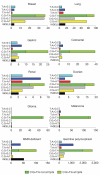Patterns of somatic mutation in human cancer genomes
- PMID: 17344846
- PMCID: PMC2712719
- DOI: 10.1038/nature05610
Patterns of somatic mutation in human cancer genomes
Abstract
Cancers arise owing to mutations in a subset of genes that confer growth advantage. The availability of the human genome sequence led us to propose that systematic resequencing of cancer genomes for mutations would lead to the discovery of many additional cancer genes. Here we report more than 1,000 somatic mutations found in 274 megabases (Mb) of DNA corresponding to the coding exons of 518 protein kinase genes in 210 diverse human cancers. There was substantial variation in the number and pattern of mutations in individual cancers reflecting different exposures, DNA repair defects and cellular origins. Most somatic mutations are likely to be 'passengers' that do not contribute to oncogenesis. However, there was evidence for 'driver' mutations contributing to the development of the cancers studied in approximately 120 genes. Systematic sequencing of cancer genomes therefore reveals the evolutionary diversity of cancers and implicates a larger repertoire of cancer genes than previously anticipated.
Figures



Comment in
-
Cancer: drivers and passengers.Nature. 2007 Mar 8;446(7132):145-6. doi: 10.1038/446145a. Nature. 2007. PMID: 17344839 No abstract available.
References
-
- Futreal PA, et al. Cancer and genomics. Nature. 2001;409:850–852. - PubMed
-
- Sawyers C. Targeted cancer therapy. Nature. 2004;432:294–297. - PubMed
-
- Manning G, Whyte DB, Martinez R, Hunter T, Sudarsanam S. The protein kinase complement of the human genome. Science. 2002;298:1912–1934. - PubMed
-
- Stephens P, et al. A screen of the complete protein kinase gene family identifies diverse patterns of somatic mutations in human breast cancer. Nature Genet. 2005;37:590–592. - PubMed
Publication types
MeSH terms
Substances
Grants and funding
LinkOut - more resources
Full Text Sources
Other Literature Sources
Molecular Biology Databases
Miscellaneous

